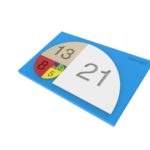
Technichal Specifications
How to use this exercise?
The model will be used to foster students’ inquiry about the mathematical laws governing our universe. The model will support the student discovery of the golden ratio, from natural objects in our planet up to distant galaxies.
Number of pieces of this exercise
12
General description
The model is composed of 10 independent pieces. The first two pieces (the two smallest) will be a quarter of a circle with 1 cm size radius, the third will have the same shape but 2 cm of radius, the fourth 3 cm, the fifth 5 cm, and so on by continuing the Fibonacci sequence (1, 1, 2, 3, 5, 8, 13, 21) up to the last piece with size 21 cm. The pieces that will compose the spiral are contained and supported by a rectangular back support, also printed in 3D and divided into two halves. This has a recess of 7.5mm to better allow the positioning of each piece.
Dimensions:
380x248x17 mm (overall)
Base, 4 pieces: 188x125x17 mm
Piece no 1. r. 10X5 mm
Piece no 2. r. 10X5 mm
Piece no 3. r. 20X5 mm
Piece no 4. r. 30X5 mm
Piece no 5. r. 50X5 mm
Piece no 6. r. 80X5 mm
Piece no 7. r. 130X5 mm
Piece no 8. r. 210X5 mm
Additional Material
Models used:
License Info
Attribution 4.0 International (CC BY 4.0) https://creativecommons.org/licenses/by/4.0/You are free to:
Share — copy and redistribute the material in any medium or format
Adapt — remix, transform, and build upon the material
for any purpose, even commercially.
Under the following terms:
Attribution — You must give appropriate credit, provide a link to the license, and indicate if changes were made. You may do so in any reasonable manner, but not in any way that suggests the licensor endorses you or your use.
No additional restrictions — You may not apply legal terms or technological measures that legally restrict others from doing anything the license permits.
Learning Specifications
How can the model be used in class?
The model will be used by the learners to explore the construction of the Fibonacci sequence and to build their own (even larger) spiral models.
What benefits can its use have?
The benefits are mostly related to the opportunity of a hands-on exploration of the model. The tactical sense, in addition to the optical one, and the practice of relating the different parts of the model by following specific geometrical rules will help the students to fit the shape of some natural objects into the Fibonacci spiral, stimulating the discussion with peers and the teacher about the golden ratio observed in nature.
Can it be used in other subjects?
Mathematics, Astronomy, Art.
